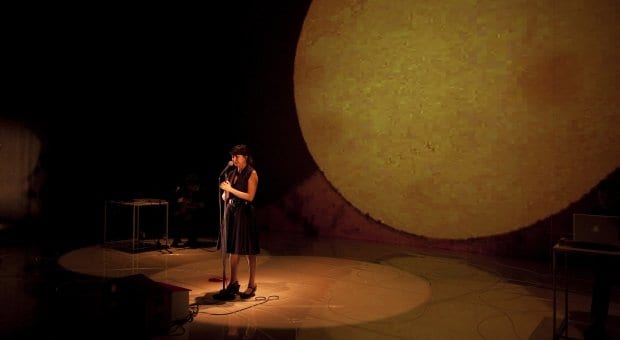An old woman imagines herself in the past, and a young girl remembers herself in the future. Time doesn’t move forward; it’s more like the crisscrossing branches of a tree’s reflection in the water. I apologize if I’m less inclined to write a review than make well-intentioned, botched attempts at poetry after experiencing a show like Me Talking to Myself in the Future.
Words are torn up and thrown into the wind to glimpse and interpret. The power behind the words expressed in Marie Brassard’s new show at Buddies is best experienced by letting one’s self get lost in them, because while there’s a story, the show is mostly non-narrative. Me Talking to Myself in the Future is something between an otherworldly rock concert and a spoken-word performance, with a heavy helping of abstract visual aesthetics.
I was thrilled to have the chance to stay for a candid audience discussion after the show with Brassard and her incredible music and sound artists, Jonathan Parant and Alexandre St-Onge. Brassard explained that she wanted to write a show for the child she used to be, a more surreal performance where things are not explained, but felt.
The story escapes even Brassard, in a way; when asked if she could explain the characters involved, she coyly evades the question as best she can. She is certainly the central character, slipping forward and backward in time, through truths and fiction, childish mind games and ancient remembrances that become motifs tied together through sound.
One of the early images she describes in the show is of children playing monsters, zombies and creepy games with one another. I was reminded of a favourite Maurice Sendak quote, “Childhood is cannibals and psychotics vomiting in your mouth,” which stayed with me through the piece. Somehow, despite images of blood and death, Me Talking to Myself in the Future didn’t strike me as particularly dark, because Brassard evokes just as much playfulness and creation.
The most impressive thing about the show technically is its sound design. For one, Brassard’s the master of voice manipulation and transformation. She credits this to hardware, what she calls “old machines,” which she prefers to more contemporary digital programs that don’t do what she wants. She is able to control “infinite parameters” to switch, at an instant, between characters that range from a child to an old woman to M0rpheus, the god of dreams. Similarly, the soundscapes created by Parant and St-Onge are hypnotizing to watch because they are with Brassard onstage, creating the sounds with instruments and digital technology in full view of the audience.
The abstract quality of the work may leave those who prefer a more straightforward, beginning-middle-and-end story feeling lost, but in this case I don’t think that’s a bad thing. I was lost, at times, but I let myself be. I just allowed myself to float, wondering what kind of stories I’m going to want to tell my past self in the future.
Me Talking to Myself in the Future runs until Sun, April 6
Buddies in Bad Times Theatre, 12 Alexander St
buddiesinbadtimes.com


 Why you can trust Xtra
Why you can trust Xtra


